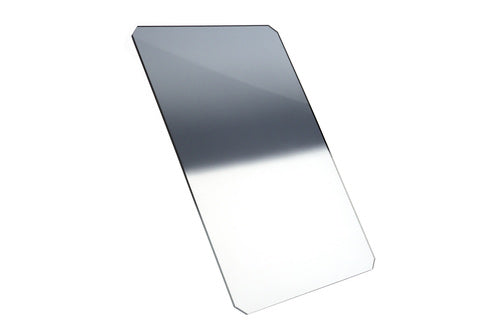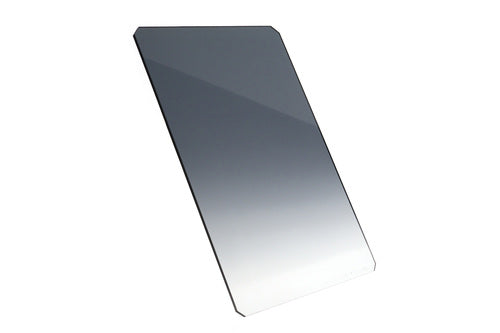
Graduated NDs, or more simply ‘grads’, have the ND effect only on the top half of the filter, so that the bright sky can be balanced with the terrain below. This correction cannot be made in post processing. Typically graduated filters are used to enhance the sky or terrain, or balance the luminosity of the sky to the luminosity of the terrain.
Graduated filters (or more simply "grads") have the effect on half of the filter. The most common use for a graduated filter is to reduce the luminosity of a bright sky balancing it to the terrain below. The advantage of using a grad filter, rather than HDR techniques is a far more neutral color representation than the "candy rainbow" side effect resulting from HDR processing. Plus, it's far more authentic and satisfying to create a great image with a single exposure, and far less work in post processing too.
Graduated ND Densities
Graduated ND filters are typically available between 1-4 or 1-5 stops of light attenuation depending on which model you choose. The most popular densities are typically 2-4 stops. To determine how much ND you need, simply spot meter the sky and then spot meter the terrain and work out the difference. If you don't carry a dedicated spot meter, you can use a spot meter app on your smartphone. They work amazingly well.
Graduated Filter Types

Soft Edge Grads are far and away the most popular type of grad. The soft transition between clear and effect allows the transition to be hidden in a scene containing variances on the horizon line - such as a mountain range. Soft grads are extremely versatile and easy to use.
Shop Formatt Hitech Soft Edge Graduated ND Filters

Hard Edge Grads feature a defined transition between the clear and effect. These filters are ideal for reducing luminance of the bright sky over a defined horizon line, such as a seascape. Hard Edge Grads are an essential tool for both fine art photographers and professional cinematographers alike.
Shop Formatt Hitech Hard Edge Graduated Neutral Density Filters

Reverse Grads feature the highest intensity of the effect near the center of the filter and reduce in intensity toward the top edge. Reverse grads are specifically designed for photographing the sunrise or sunset when the highest luminosity is near the horizon. Although less well known than hard and soft grads, those who know about reverse grads love them. While creating our Landscape Filter Kit, Colby Brown insisted that a reverse grad be included.

Blenders feature a transition that occurs over the entire length of the filter from top to bottom (or bottom to top, because remember that all grads can be used with the effect on the bottom as well). Blenders are used when the scenery and horizon are too complex to hide the transition of a soft edge filter.

Color Grad filters come in every color of the rainbow and more. Beyond single color grad filters, we also made complicated color grads such as the sunset and twilight grads that have complex graduations from red-orange-yellow and blue-violet-magenta respectively. It's a great way to enhance the fire or tranquility of your sky. Color grads are typically available in densities of 1, 2, 3. These densities don't correspond to specific stops of light reduction like ND grads. Rather, you can think of 1,2,3 as simply light, medium, heavy.
Graduated ND Filter Materials
Grad filters are available in both resin, traditional glass and Firecrest glass. The resin grad and traditional glass range includes everything we make, all colors, twilight & sunset, and NDs in all transitions including soft, hard, reverse and blender.
Firecrest grads are only available in a select range of soft edge ND grads for photo and cinema.
Circular Neutral Density Filters
We make a limited selection of graduated filters in circular too. However, circular can only be adjusted on the rotational axis and not on the rise-fall axis. So, we recommend rectangular grads. But if you must go with a circular grad, choose a soft edge and a lower density.
<div class="dynamic-checkout__content" id="dynamic-checkout-cart" data-shopify="dynamic-checkout-cart"> <shopify-accelerated-checkout-cart wallet-configs="[{"name":"shop_pay","wallet_params":{"shopId":26799341677,"merchantName":"Formatt Hitech USA","personalized":true}},{"name":"paypal","wallet_params":{"shopId":26799341677,"countryCode":"US","merchantName":"Formatt Hitech USA","phoneRequired":false,"companyRequired":false,"shippingType":"shipping","shopifyPaymentsEnabled":true,"hasManagedSellingPlanState":false,"requiresBillingAgreement":false,"merchantId":"U73T3ZU9AJ8J4","sdkUrl":"https://www.paypal.com/sdk/js?components=buttons\u0026commit=false\u0026currency=USD\u0026locale=en_US\u0026client-id=AbasDhzlU0HbpiStJiN1KRJ_cNJJ7xYBip7JJoMO0GQpLi8ePNgdbLXkC7_KMeyTg8tnAKW4WKrh9qmf\u0026merchant-id=U73T3ZU9AJ8J4\u0026intent=authorize"}}]" access-token="67b9bed4423c0c83b25594230fdfcd83" buyer-country="US" buyer-locale="en" buyer-currency="USD" shop-id="26799341677" cart-id="92874f91ad2fd15568d6ee429fe689d1" > <div class="wallet-button-wrapper"> <ul class='wallet-cart-grid wallet-cart-grid--skeleton' role="list" data-shopify-buttoncontainer="true"> <li data-testid='grid-cell' class='wallet-cart-button-container'><div class='wallet-cart-button wallet-cart-button__skeleton' role='button' disabled aria-hidden='true'> </div></li><li data-testid='grid-cell' class='wallet-cart-button-container'><div class='wallet-cart-button wallet-cart-button__skeleton' role='button' disabled aria-hidden='true'> </div></li> </ul> </div> </shopify-accelerated-checkout-cart> <small id="shopify-buyer-consent" class="hidden" aria-hidden="true" data-consent-type="subscription"> One or more of the items in your cart is a recurring or deferred purchase. By continuing, I agree to the <span id="shopify-subscription-policy-button">cancellation policy</span> and authorize you to charge my payment method at the prices, frequency and dates listed on this page until my order is fulfilled or I cancel, if permitted. </small> </div>











